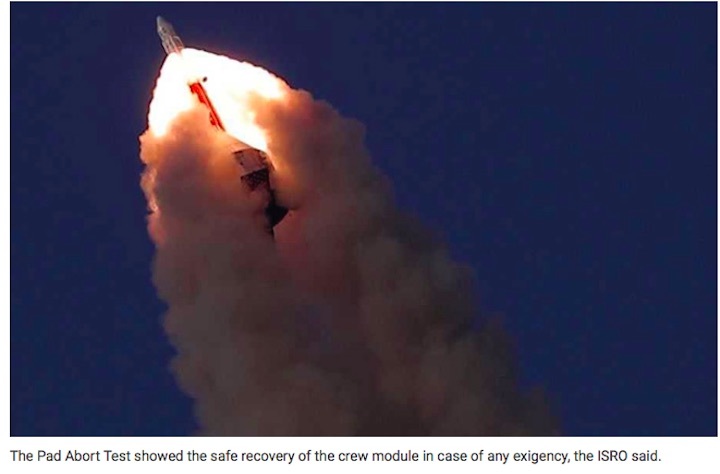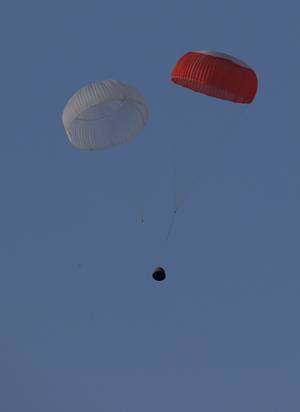5.07.2018

SUCCESSFUL FLIGHT TESTING OF CREW ESCAPE SYSTEM - TECHNOLOGY DEMONSTRATOR
ISRO carried out a major technology demonstration today (July 05, 2018), the first in a series of tests to qualify a Crew Escape System, which is a critical technology relevant for human spaceflight. The Crew Escape System is an emergency escape measure designed to quickly pull the crew module along with the astronauts to a safe distance from the launch vehicle in the event of a launch abort. The first test (Pad Abort Test) demonstrated the safe recovery of the crew module in case of any exigency at the launch pad.
After a smooth countdown of 5 hours, the Crew Escape System along with the simulated crew module with a mass of 12.6 tonnes, lifted off at 07.00 AM (IST) at the opening of the launch window from its pad at Satish Dhawan Space Centre, Sriharikota today. The test was over in 259 seconds, during which the Crew Escape System along with crew module soared skyward, then arced out over the Bay of Bengal and floated back to Earth under its parachutes about 2.9 km from Sriharikota.

The crew module reached an altitude of nearly 2.7 km under the power of its seven specifically designed quick acting solid motors to take away the crew module to a safe distance without exceeding the safe g-levels. Nearly 300 sensors recorded various mission performance parameters during the test flight. Three recovery boats are being exercised to retrieve the module as part of the recovery protocol.
Quelle: ISRO
---
Update: 6.07.2018
.
ISRO’s first ‘pad abort’ test, critical for future human space mission, successful

Crew Escape System is an emergency escape measure to quickly pull the the astronaut cabin along with crew out to a safe distance from launch vehicle during a launch abort.
The first 'pad abort' test critical for a future human space mission was conducted successfully on Thursday morning, the Indian Space Research Organisation has announced. The test was conducted at the Satish Dhawan Space Centre, Sriharikota.
“The Pad Abort Test demonstrated the safe recovery of the crew module in case of any exigency at the launch pad,” the space agency said.
Describing it as a major technology demonstrator the space agency said the PAT (pad abort test) is the first in a series of tests to qualify a crew escape system technology of a manned mission in the future.
The Crew Escape System is an emergency escape measure to quickly pull the crew module — the astronaut cabin — along with astronauts out to a safe distance from the launch vehicle in the event of a launch abort.
ISRO Chairman K.Sivan said the teams also tried out at least five new secondary technologies related to satellite communication, navigation and telemetry during the test. A few more trials related to the safety of astronauts would be taken up later.
The countdown began at 2 a.m., five hours ahead of the test. At 7 a.m., the Crew Escape System with a simulated 12.6-tonne crew module lifted off from its pad.
It was propelled on its own seven specially made complex in-built rockets. In the next four-odd minutes, it reached a height of 2.7 km and curved down into the Bay of Bengal on parachutes. It landed in sea at a distance of 2.9 km from the launch centre.
Three recovery boats were sent out to retrieve the module.
The rockets are solid-fuel powered and specially designed for quickly ejecting the crew module and astronauts to a safe distance without exceeding the safe G-levels, an ISRO statement said.
Nearly 300 sensors recorded various functional aspects of the mission during the test flight.
Quelle: The Hindu
---
